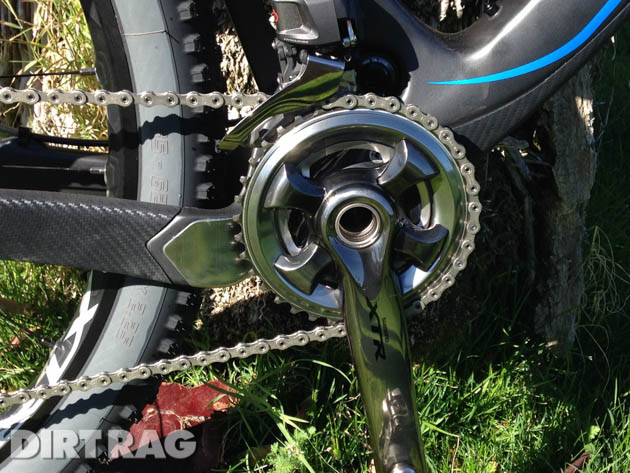Dirt Rag’s first test-ride on Shimano’s electronic XTR Di2: Part 1
Originally posted on February 11, 2015 at 12:41 pm
Shimano unveiled its fleet of long-term test bikes for its revolutionary electronic XTR mountain bike shifting in sunny Palm Springs, California. My bike is the potent Pivot Mach 429 Carbon, which is one of the first available to be designed specifically for all internal Di2 wire routing as well as battery storage. After a few shake down rides here in Palm Springs I’ll be going directly to 24 Hours in the Old Pueblo as a solo racer to get more time on the product before taking it home to the east coast.
Since XTR Di2 has had plenty of media coverage already but little actual ride reviews I’ll break this down into multi part reports. First, I’ll begin with my setup choices.

Because this this is going to be a cross-country race bike I was able to secure the 160 gram Pro Tharsis XC Flat Di2 bar and 145 gram stem. These two pieces are designed to run the Di2 wires internally, through the fork’s steerer, out the stem and inside the bar where a small port near the lever mount is located to bring out the wire. Additionally, Shimano mechanics added a little something special: In addition to the wire junction in the frame they added another one inside the stem. Everything is plug and play and it was ultimately pretty easy to do thanks to a multitude of wire lengths available. Doing this made what I did next very simple.
Right off the bat I wanted the full experience of a double ring set up without a front shifter so I had it removed even before riding the bike. In this case, imply remove the handlebar, pull out the junction box hidden in the stem and unplug the front shifter.

Next up was programming. Out of the box the shifters felt reversed from the traditional cable triggers (the upshift and downshift buttons were backwards) so I had the mapping changed to match that for which button up and downshifted. Anyone with a PC (no Mac compatibility yet and it’s not certain when) can adjust the performance in a nearly unlimited way.

Want to have right and left shifters that both control the rear derailleur? Sure. How about make the right side all upshift and the left all downshift for the rear? No problem. Of course you can also leave them stock and have traditional front and rear shifting. The basic S1 and S2 setting worked fine (there’s also manual which eliminates auto front shifting) but I went deeper with a custom program that one of the on-site Shimano techs created to better suit my riding style.

The new S1 map is based around riding in the big ring longer while S2 is based around staying in the inner ring longer. Both setting also increased the how many gears the rear derailleur automatically moves as well as when the front shift happens. I also increased the speed in when the derailleur moves across the cassette. As you can see, there is a lot of customization available.
The first two short rides were incredible. The performance of XTR Di2 is amazing and so far is delivering as promised. Stay tuned for more reports on how it works after more miles are packed on. This is just the beginning of our long term testing.